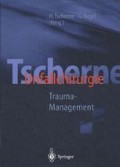Zusammenfassung
Die Behandlung Unfallverletzter ist eine medizinische Aufgabe von hohem ethischem Rang. Sie hat in den letzten Jahren einen grundsätzlichen Wandel erfahren. Das heutige präklinische und klinische multidisziplinäre Management des Schwerverletzten zeigt beispielhaft die Geschwindigkeit auf, mit der sich die Medizin entwickelt. Die Versorgung Schwerund Mehrfachverletzter erfordert ein Höchstmaß an Organisation, eine gut ausgebaute Logistik und einen hohen Ausbildungsstand der behandelnden Ärzte.
Access this chapter
Tax calculation will be finalised at checkout
Purchases are for personal use only
Preview
Unable to display preview. Download preview PDF.
Literatur
Baker SP, O’Neill B, Haddon W, Jr., Long WB (1974) The injury severity score: a method for describing patients with multiple injuries and evaluating emergency care. J Trauma 14: 187–196
Boyd CR, Toison MA, Copes WS (1987) Evaluating trauma care: the TRISS method. Trauma Score and the Injury Severity Score. J Trauma 27: 370–378
Champion HR, Sacco WJ, Carnazzo AJ, Copes W, Fouty WJ (1981) Trauma score. Crit Care Med 9: 672–676
Champion HR, Copes WS, Sacco WJ et al. (1990a) The Major Trauma Outcome Study: Establishing national norms for trauma care. J Trauma 30: 1356–1365
Champion HR, Copes WS, Sacco WJ et al. (1990b) A new characterization of injury severity. J Trauma 30: 539–546
Champion HR, Copes WS, Sacco WJ, Frey EF, Holcroft JW, Hoyt DB, Weigelt JA (1996) Improved prediction from ASCOT over TRISS: Results of an independent study. J Trauma 40: 42–49
Copes WS, Champion HR, Sacco WJ (1990) Progress in characterizing anatomic injury. J Trauma 30: 1200–1207
DeMaria EJ, Kenney PR, Merriam MA, Casanova LA, Gann DS (1987) Survival after trauma in geriatric patients. Ann Surg 206: 738–743
Dittmer H, Faist E, Lauterjung KL, Heberer G (1983) Die Behandlung des Polytraumatisierten in einem Klinikum. Chirurg 54: 260–266
Emerman CL, Shade B, Kubincanek J (1991) A comparison of EMT judgment and prehospital trauma triage instruments. J Trauma 31: 1369–1375
Ertel W, Faist E (1993) Immunologisches Monitoring nach schwerem Trauma. Unfallchirurg 96: 200–212
Finelli FC, Jonsson J, Champion HR, Morelli S, Fouty WJ (1989) A case control study for major trauma in geriatric patients. J Trauma 29: 541–548
Goris RJ, te Boekhorst TP, Nuytinck JK, Gimbere JS (1985) Multiple-organ failure. Generalized autodestructive inflammation? Arch Surg 120: 1109–1115
Gormican SP (1982) CRAMS Scale: Field triage of trauma victims. Ann Emerg Med 11: 132–135
Martin RE, Teberian G (1990) Multiple trauma and the elderly patient. Emerg Med Clin North Am 8: 411–420
Nast-Kolb D, Kessler S, Duswald KH, Betz A, Schweiberer L (1986) Extremitätenverletzungen polytraumatisierter Patienten: stufengerechte Behandlung. Unfallchirurg 89: 149–154
Nast Kolb D, Jochum M, Waydhas C, Schweiberer L (1991) Die klinische Wertigkeit biochemischer Faktoren beim Polytrauma. Hefte Unfallheilkd 215: 1–162
Nast-Kolb D, Waydhas C, Kanz G, Schweiberer L (1994) Algorithmus für das Schockraummanagement beim Polytrauma. Unfallchirurg 97: 292–302
Oestern HJ, Kabus K (1994) Vergleich verschiedener Traumascoresysteme. Unfallchirurg 97: 177–184
Oestern HJ, Tscherne H, Sturm J, Nerlich M (1985) Klassifizierung der Verletzungsschwere. Unfallchirurg 88: 465–472
Pachter HL, Hofstetter SR, Liang HG, Hoballah J (1989) Traumatic injuries to the pancreas: the role of distal pancreatectomy with splenic preservation. J Trauma 29: 1352–1355
Regel G, Lobenhoffer P, Lehmann U, Pape HC, Pohlemann T, Tscherne H (1993) Ergebnisse in der Behandlung Polytraumatisierter. Eine vergleichende Analyse von 3406 Fällen zwischen 1972 und 1991. Unfallchirurg 96: 350–362
Roumen RM, Hendriks T, Wevers RA, Goris JA (1993) Intestinal permeability after severe trauma and hemorrhagic shock is increased without relation to septic complications. Arch Surg 128: 453–457
Schweiberer L, Dambe LT, Klapp F (1978) Die Mehrfachverletzung: Schweregrad und therapeutische Richtlinien. Chirurg 49: 608–614
Teasdale G, Jennett B (1974) Assessment of coma and impaired consciousness. A practical scale. Lancet 2: 81–84
Trunkey DD (1984) Is ALS necessary for pre-hospital trauma care? [editorial]. J Trauma 24: 86–87
Tscherne H (1969) Der schwere Unfall: Erweiterte Erste Hilfe — Reihenfolge der Versorgung. Chir. Univ.-Klinik Graz, S.151-156
Waydhas C, Nast Kolb D, Kick M et al. (1994) Operationsplanung von sekundären Eingriffen nach Polytrauma. Unfallchirurg 97: 244–249
Wolff G, Dittmann M, Frede KE (1978) Klinische Versorgung des Polytraumatisierten. Indikationsprioritäten und Therapieplan. Chirurg 49: 737–744
Editor information
Editors and Affiliations
Rights and permissions
Copyright information
© 1997 Springer-Verlag Berlin Heidelberg
About this chapter
Cite this chapter
Oestern, H.J., Regel, G. (1997). Allgemeine Aspekte. In: Tscherne, H., Regel, G. (eds) Tscherne Unfallchirurgie. Springer, Berlin, Heidelberg. https://doi.org/10.1007/978-3-642-59215-7_9
Download citation
DOI: https://doi.org/10.1007/978-3-642-59215-7_9
Publisher Name: Springer, Berlin, Heidelberg
Print ISBN: 978-3-642-63901-2
Online ISBN: 978-3-642-59215-7
eBook Packages: Springer Book Archive

